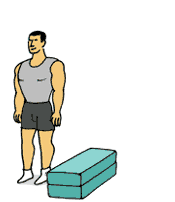Here’s a collection of 5 soccer conditioning drills that reproduce the physical demands of the game.
Cherry-pick those that appeal to you or use them all for an intense fitness session.
I’ve included a ball as much as possible, even if it’s just a token gesture – every effort to make soccer conditioning drills more specific to the game will pay off on the field.
Drill #1 – Tight Space Dribbling
If you have the luxury of having a ball per person this is a great drill to develop touch and fitness simultaneously.
- Perform this drill towards the start of a session – following the warm up and before more physically demanding drills.
- Mark out a space about 20×20 yards (for 15 players). Adjust the size according to the number of players.
- For 60 second intervals have the players ‘express’ themselves with the ball. They should try turns, feints and tricks. Encourage players not to running round in a circle (which WILL happen at first). They should change direction constantly and randomly.
- Decrease the size of the area after each 60 second bout and repeat for 5 or 6 intervals with a 20-30 second break between.
For Soccer Players & Coaches of All Ages:
Significantly improve your own (or your team’s) performance and consistency on the pitch. My complete guide to professional-level soccer conditioning will show you how to beat the competition at any level.
Drill #2 – Two Versus Two with a Spare
- In groups of five, two players act as attackers and two players act as defenders. One player is spare and should wear a bib or vest to stand out.
- Mark an area of approximately 12-15 yards square. The attackers are given possession of the ball.
- The spare player is an attacker – in effect he or she is always on the side of the team in possession.
- The defenders must dispossess the attackers by intercepting the ball. They also receive possession if the ball goes out of the marker area.
- Bouts of 2 minutes is ample and the floating player should change at each interval.
This drill is physically demanding but tactically quite clever. The defending pair must work hard but smart. The team in possession can relax but they will stay alert because giving the ball away means hard work to come.

Drill #3 – Step Jumps
This is a plyometric exercise and should be completed towards the beginning of the session but only after a thorough warm up.
- Stand beside a cone or soft object to be cleared.
- Bring knees up and jump vertically but also laterally off ground and over the marker.
- Land on both feet and jump back in the other direction.
- Ground contact time should be minimal – don’t dip into a full squat position.
- Repeat for 30 seconds maximum and a total of 3 sets.

Drill #4 – Killer Shuttles
Simple. Excruciating. But very effective. You can perform this drill on your own or as part of a group in a line. Leave this soccer conditioning drill until the end of a training session because it can leave legs feeling weak (not ideal for skill practise!).
- Place 5 cones out 10 yards apart.
- Starting on cone 1, run to cone 2 and back, then cone 3 and back, 4 and back, then 5 and back.
- The sprint should be flat out and players should turn sharply off a different foot at each cone.
- Rest for 30 seconds and repeat. Rest another 30 seconds and repeat for a third time. This is one set. Now rest for 2 minutes and repeat for a second set (i.e. 3 lots of shuttle runs with 30 seconds rest between each).
- Now do a cool down to disperse all that lactic acid!
Use these and similar soccer conditioning drills to build speed, strength and power – specific to the game.

Jacky has a degree in Sports Science and is a Certified Sports and Conditioning Coach. He has also worked with clients around the world as a personal trainer.
He has been fortunate enough to work with a wide range of people from very different ends of the fitness spectrum. Through promoting positive health changes with diet and exercise, he has helped patients recover from aging-related and other otherwise debilitating diseases.
He spends most of his time these days writing fitness-related content of some form or another. He still likes to work with people on a one-to-one basis – he just doesn’t get up at 5am to see clients anymore.
